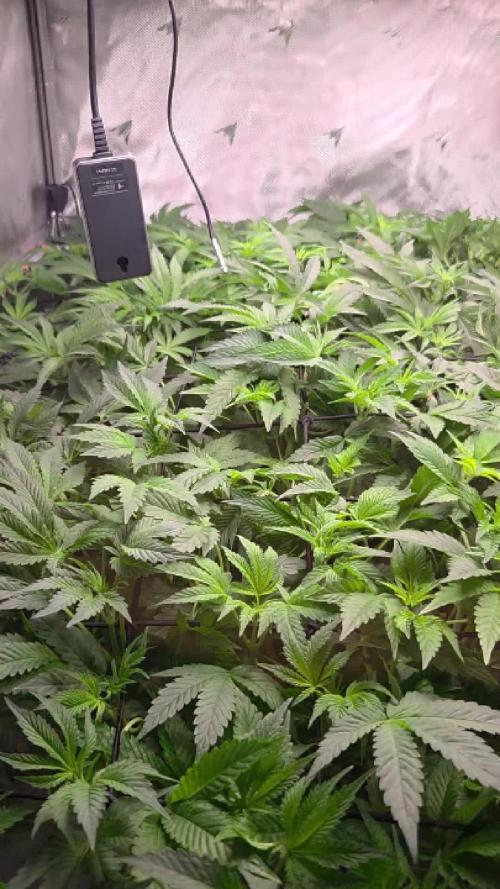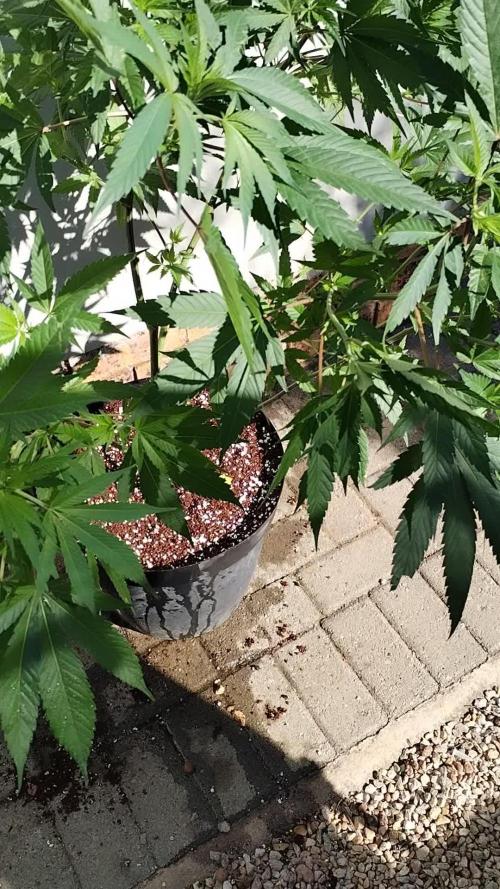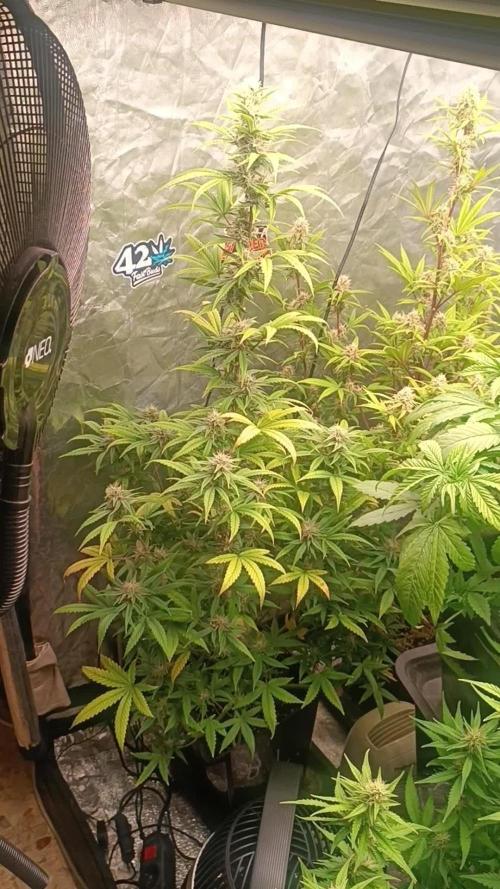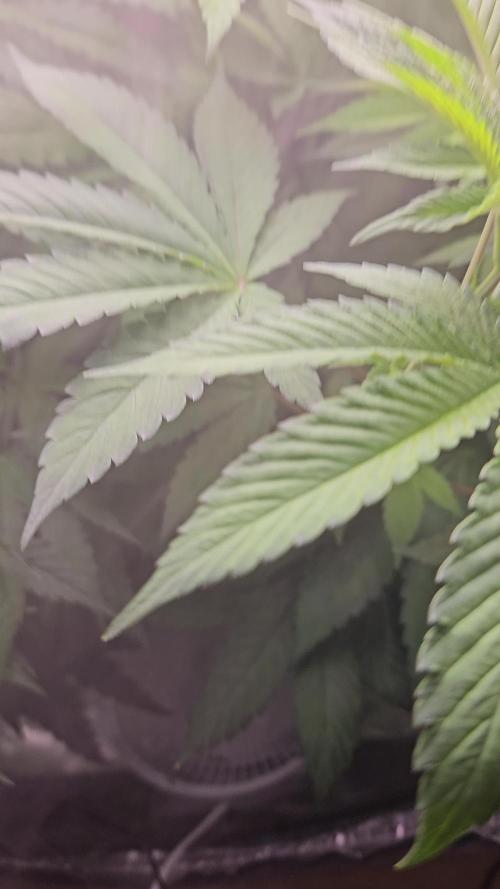The Grow Awards 2026 🏆 































Likes
Comments
Share


@AlbaDiary2
Follow
Buenos humos queridos jardineros!!💚
Espero que la semana fuera bien!
Yo aquí, con las Novarine que no paran de crecer y crecer, son altísimas!
(Casi más que yo, para ser sincera😂)
Están muy olorosas y sacando bellos cogollos!
Nos vemos para la siguiente semana con más!
A pensar en verde💚💚💚💚💚😘😘😘😘😘
Likes
93
Share


@LGreen
Follow
🌱 Wieder mal einen schönen Sonntag & zweiten Advent für die, die es betrifft 😊
🌿 Wochenupdate
Die Woche war wieder bisschen was los… leider =D
Ich versuche wieder alles so transparent wie möglich zu machen 😊
Zu Beginn habe ich meine Lösung wie gewohnt manuell mit hochwertigen Apera-Messinstrumenten kontrolliert angemischt und behandelt.
Das lief auch immer perfekt, bis es leicht überhand genommen hat 😅
Ich habe locker 7-mal am Tag gemessen und dementsprechend anschließend gereinigt…
Nach ein wenig Überlegen habe ich mich dann schließlich doch für einen Bluelab Guardian entschieden.
Anfangs wollte ich nicht so viel in reinen Komfort investieren, aber mir persönlich wurde es einfach zu viel, weil ich zu oft wissen möchte, was los ist =D
Letzte Woche hatte ich ja bereits erwähnt, dass ich den Stretch-Peak anhand der EC- und pH-Kurven bestimmen konnte.
Das lief schon alles über den Bluelab. Da ich wirklich gerne datenbasierte Entscheidungen treffe, habe ich ab diesem Moment weiter fleißig runtertrainiert und die Werte beobachtet um den richtigen Zeitpunkt zum sortieren zu erwischen .
Der Trend war dann aber erst mal, dass sie einfach wie verrückt weiterziehen 😄
Am 4. Tag bei diesem Messverhalten wäre es fast passiert…
Der Uptake hat über eine Dunkelphase so dermaßen zugenommen, dass ich es mir nicht mehr erklären konnte (Peak-Messung × 2,5).
Fakt war aber: Das Reservoir war von den Werten her wirklich in einen kritischen Bereich gerutscht und ich wollte das ändern.
Warum das so war, dachte ich mir: kann ich auch später klären… schließlich haben die Ladys Hunger =D
Also habe ich wie immer 30 L Top-Up berechnet, gemischt und auf etwa 4,30 mS/cm eingestellt, damit ich die niedrigen RESS-Werte wieder nach oben bekomme.
Zum Glück habe ich auch meine Momente, man mag’s nicht glauben 😄 Ich habe random beim Abpumpen mal den Drain gemessen, weil es mir keine Ruhe gelassen hat – und siehe da: 1,9 mS/cm.
Die Sonde hatte sich über die Wochen ordentlich in einen Wurzelballen geschoben und dadurch zwar konstante Werte geliefert, aber eben in einer Wurzel-Biozone und nicht im freien Draftwasser.
Das klingt erst mal nicht dramatisch , aber wenn mir das nicht aufgefallen wäre, hätten die Damen rund 24 h in einem hochtoxischen Bereich gestanden… Das wären sicher ein Ordentlicher stepback gewesen...
Und natürlich passiert das Ganze in einer Phase, in der ich ihnen so wenig Stress wie möglich machen möchte 😄
Ich habe jetzt aus grobem Filterschwamm kleine „Hüllen“ gebaut, die aktuell ihren Dienst tun und die Wurzeln fernhalten.
Drain-Messen ist ab jetzt auf jeden Fall SOP 😄
Da der Guardian erst während des Runs eingezogen ist, konnte ich ihn leider nicht ordentlich verbauen..
🌿 Pflanzenstatus & Training
Zur Sicherheit gehe ich wieder Back to Basics und trainiere so lange weiter, bis der Rebound-Stretch sichtbar nachlässt 😊 Das sollte jetzt die Tage geschehen.
Den nächsten Run gestalte ich hier definitiv anders 😄 Ich brauch doch meine Werte fürs Timing…
Anschließend nur noch die Meshes bestücken, langsam am Klima schrauben – und wachsen lassen 😊
⚙️ System
Bis auf die Panne mit der Sonde läuft das System nach wie vor perfekt.
Am Vorgehen mit berechneten, gezielten Lösungen hat sich nichts geändert 😊
800 PPFD
1,0 kPa VPD
700–800 ppm CO₂ im Durchschnitt
💚 Special Mention
Da geht auf jeden Fall was 😄
Ich glaube, an dem Punkt kann man echt davon sprechen, dass sie durch ist.
Sie ist nicht ganz so gut entwickelt wie ihre Schwestern – aber trotzdem eine sehr vitale Pflanze, die sich echt zurückgekämpft hat 😄💚
Danke fürs Lesen und eine schöne Woche euch 😊!
Likes
2
Share


@pendeja420
Follow
Wow!! It was sunny and hot all week! You can see that they almost doubled their size and are looking pretty much more healthy. That is also because I followed @MadeInGermany 's advice and decided to wait more until I had to water. They seem to have liked that, beacuse there is no more sign of Ca blocking in the leaves. And they grew very nicely, no need of everything. Also following his advice I will use Cal/Mag in the next watering. But, you know, I'm making it cheap... so I will use another home-made recipe: wood ash fertilizer, which include those nutrients and some that are needed in flowering stage -which seems to be starting, so next week will have the flowering label-. It also degrades the N in the soil that could be still causing a little overfeeding (leaves' tips are a bit burnt). However, I admit that my mistake was overwatering from the beggining. Lesson learned! No watering for the whole week and the plnat didn't seem to worry about it.
Man! If only it had been this sunny all the time! Plants look very healthier and are way bigger, with huge new leaves. A little amount of pistils showed up in the last days, so I guess it is the moment for stretching. Knowing that, I decided to do a little training on Sweet, as it is the one a bit behind. You can see in the last picture how I took a couple leaves that were blocking light from side branches-future bud sites- and taped them, so they didn't. If results are good I might do the same with Rebel, but I have a feeling that she'll do good without it.
Sadly, next week will be all rainy and cloudy... Nothing to do tho. Any commentary will be thanked, even if it is about how cheesy the videos are! 😂
Processing
Likes
11
Share


@OrganicAlphapak420
Follow
Fed only distilled water every 3-5days. Lowered the lights down to 14 in from the tops...stopped all training. Pretty much just letting them grow without bothering them. Just keeping an eye on the temps n humidity daily. Easy relaxing grow.
Likes
Comments
Share


@Canabisseurs
Follow
This week, Tart Pops got a serious upgrade — moved into a big 50L pot and loving the legroom! Roots were wrapping tight around the old pot, so it was time to stretch out and settle in. Gave her a solid flush to clear out any leftover salts before the big shift.
She’s heading straight into flower mode in the tent after this — lights, camera, pistils!
Expecting explosive growth in the next 7–10 days as she settles into the new digs and switches gears. Let the bloom begin!
Next Up:
Monitor transition stretch
Light feeding after flush
First signs of flower incoming…
Likes
4
Share


@eldruida_lamota
Follow
Vamos familia, actualizamos la cuarta semana de vida de estas Thunder Banana de Seedstockers, salieron las 3 de 3, 100% ratio éxito.
Aplicamos varios productos de Agrobeta, que son increíbles para aportar una buena alimentación a las plantas.
Temperatura y humedad dentro de los rangos correctos dentro de la etapa de crecimiento.
La tierra utilizada es al mix top crop, por cambiar.
De 3 ejemplares seleccioné los 2 mejores para completar el indoor y apliqué el tetra 9 vía foliar, se ven bien sanas las plantas, tienen un buen color y progresan a muy buen ritmo por el momento.
Agrobeta:
https://www.agrobeta.com/agrobetatiendaonline/36-abonos-canamo
Hasta aquí todo, Buenos humos 💨💨💨
Likes
19
Share


@Mo_Powers
Follow
the 9th week. it's slowly starting to smell. but it's a really faint odour. the trichomes are starting to turn milky and the pistils are changing colour. i think it will be ready for harvesting in 1 to 2 weeks. it still looks very healthy. i hope the next few weeks will be really sunny again. unfortunately it's very changeable weather at the moment
Likes
57
Share


@AsNoriu
Follow
Day 50 since seed touched soil. They overgrew everything !!! Devil is HUGE and strong and hungry ;)))) . I think i was late with top up, they developed fast and used a lot. I check run off for ppm, but thought 800 still ok, it was not. So big last top up !!! plus to call it measuring would be sin, i collect all run off, mixed from all 3 plants, but its still gives small feel.
ALL NUTRITIONS ARE GRAMS TO POT LITRES !!!! Neutralise is in real measurement only.
Great White - 3 g each pot
Biosys - 3g each pot
Charge - 30 g each pot
Life-Cycle - 60 g each pot
Bio-Blend - 100 g each pot
Watered straight after, 4 liters went in.
Some girls are almost brushing Mars Hydro TSL2000 and i see no issues if air is moved and temp with humidity allows it. Great light, plants grow very well, too well ;)))) will do new clearing after two waterings, want girls to eat first, make bigger roots, then i will resize again to concentrate more on tops.
MARS HYDRO TSL2000: 300W, Flower 2'x4', Veg 3'x5'
It's recommended for beginners.
Low-budget & high-efficiency.
Took down first time ever LST while still growing. Needed space of pot, for last top up and i think they will breath better without, branches are stiff, i would add silica to feed at such time, to stiff them, but i go with one line only, just full beans ;)))
Happy growing !!!
Likes
7
Share


@JeyGanesha
Follow
Questa frostbanger sta crescendo super forte... Dopo il blocco che ha avuto la prima settimana. Adesso sta buttando fuori tanta Massa vegetale😂💪👍forza bella piantina mia continua così🤣🤣
Likes
15
Share


@gottagrowsometime
Follow
Welcome to my Lemon Drizzle Diary Sponsored by Spider-Farmer & Barneysfarm.
1 Month Update in 1 Week.
Trying a new thing, with so many diaries. I really don't need to be doing so many updates in 1 week. So, for most of my diaries apart from one I'm in contract with. I'll be applying up to 14-21 days in 1 week. This was let go for over a month. I'm giving you a month of her growth. She really is another few weeks ahead in Real Time.
Days 15-42 Veg Days 10-37 weeks 3-6 1 month.
Plant done very well in her early weeks coming into wk 3 she has 10 days of veg and a considerable root zone. (That was root bound) been a fem. Id no concerns about losing her roots at the end. I then decided to go for another smaller but slightly bigger pot for a few weeks to get roots going again fast that won't be an bound like that. After a few weeks coming into wk 6 I put her into her final 11L pot. And she flourished. She pult herself out of the light green edges she suffered from been stuck in a another small pot (her roots found it hard to catch their breath been root bound) but, roots are literally coming out the end of the 11L pot now. She's at the end of wk 6 after going through hard defoliations at the start of wk 3 well into and beyond wk 6. And I've made myself 4 very nice tight long nodes with lots of inters built up. When she's put to into pre flower this week I'll start to open her up lightly. Not much. As there is only 4 nodes so, there's not much to LST but pulling them slight apart from each other.
Light
SE5000 is doing a smashing job. I've only had it up to 85%. Really good co2 light. And this lady is far away from the light. So, she's maybe getting 45% of her power. She's getting 40k lux. When its in fattening she'll be getting 65-70k
Co2
Is kept between 8-1300. Average is 1000. Temp is between 31-33c slight dip.
Thanks to Barneysfarm for their 2022-23 Releases. And to Spider-Farmer for allowing me to try their new Upgraded 2023 Spectrum SE5000. Both amazing companies with great products in their own right.
Much appreciated for the support. Thanks for stopping by. I look forward to seen your work. Either way, thanks for dropping in.
Likes
13
Share


@Robeeriegenetics
Follow
Plants recovering well …heat is causing some problems in the indica room otherwise all is well …1 more week till flush then 1 more week after that til harvest
Likes
2
Share


@D33jW
Follow
📅 Week 5 – Day 35 / FLO 7
BOX: 50x50 - lampa 100W
🌞 Temp: 26°C
💦 RH: 62 - 64%
💥 PPFD: 700 µmol
🌬️ VPD: 1.3
Both showed their sex on the same day, so it’s looking good – they’re developing evenly.
I’m watering daily with 600–800 ml (5L pots), EC between 0.8 and 1.1.
Likes
145
Share


@Salokin
Follow
Hello Growmies,
As we observe the growth in week 15, I'm filled with both anticipation and awe.
She continues her impressive swell, and new white hairs have emerged, suggesting that the end of January might be too soon for harvest. The delicate balance of maturity is playing out before us, as the first few trichomes take on an amber coloration, signaling the onset of peak ripeness.
There's a noticeable increase in her aromatic presence – she's getting louder, so to speak, filling the space with her potent scent. A beautiful fade is underway; the lower canopy leaves have turned a bright yellow and are gracefully falling away, a natural progression as she directs her energy to the buds. These, in turn, are taking on a striking purple hue, which is becoming more pronounced day by day. Each day brings a change, a new layer of complexity to her form. The way she's maturing, the hues she's revealing, and the scents she's exuding all contribute to the feeling that she's one of the most remarkable plants I've grown. Her feeding remains consistent at 4 liters of nutrient solution every four days, sustaining her through this critical phase. The light spectrums continue at full capacity, and she seems to savor every photon that falls upon her.
With new growth still apparent, I'm considering adjusting the harvest timeline. Patience is key, as is careful observation of her trichomes and overall health.
We're entering what may be the final stretch, but only time will tell. The yellowing of her leaves, the purpling of her buds, and the sweet, loud fragrance she's giving off are all signs of a successful grow coming to fruition.
Stay tuned for next week's entry, where we'll delve deeper into her readiness for harvest and the splendid transformation that's taking place.
Stay Lifted
Salokin
Likes
5
Share


@GarciasGarden
Follow
Well mother fu**** woke up one morning and saw that one of the NANAZ got something that looks like nute burn (keep in mind I feed them all the same exact thing!) what happened to that plant should of happened to the others but what a pain in the ass.. it is completely brown now and I think I’m chopping it no room for uglies in the tent!
Processing
Likes
42
Share


@MadeInGermany
Follow
Hey everyone 😀.
This week both Phenos continued to grow super 🙂.
They were also sprayed again with neem oil, which is why they look so dark and shine :-).
All trips are apparently gone, but safety first 🙂👍.
The week I will apply topping again, that it will be real bushes 😅.
I wish you all a lot of fun with the update, and let it grow 👍
You can buy this Strain at :
https://sweetseeds.es/de/cream-caramel/
Type:
Cream Caramel
☝️🏼
Genetics:
Blue Black
x
Maple Leaf Indica
x
White Rhino
👍
Vega lamp:
2 x Todogrow Led
Quantum Board 100 W
💡
Bloom Lamp :
2 x Todogrow Led
Cxb 3590 COB 3500 K 205W
💡💡☝️🏼
Soil :
Canna Coco Professional +
☝️🏼
Fertilizer:
Green House Powder Feeding
☝️🏼🌱
Water:
Osmosis water mixed with normal water (24 hours stale that the chlorine evaporates) to 0.2 EC. Add Cal / Mag to 0.4 Ec Ph with Organic Ph - to 5.5 - 5.8 .
Likes
28
Share


@cyberkyd
Follow
Just an OKAY Week. Nothing miraculous. Growth is as stunned as expected due to over exposure to high PPFD I presume since they all look healthy in every other way except the height and density for a 2 week old vegging plant. It's not that of a weed.
Transplanted them all into 3 Gal Fabric Pots, Except Gelato which is looking pointeless to plant at this stage.
Feeding every second day about 250 ml per plant.
Feeding Schedule
2 ML/Gal CalMag
2.5 ML Micro
2.5 Grow
1 ml Bloom.
PH Down at 5.8
to safeguard against the odd's I sowed another Gelato seed to the fam on 10th Feb. Will Create a separate diary for that grow.























